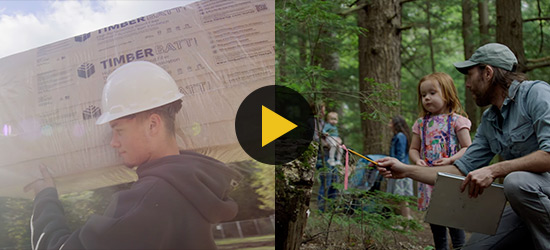Safe, Reliable, Sustainable Insulation. That’s Our Promise.
Sustainability is more than one thing – it’s about responsible sourcing, low-impact manufacturing, high-performance materials, and supporting a circular economy.

Saving Carbon While Storing Carbon
Wood fiber allows us to tackle carbon emissions on two fronts: operationally, by reducing heating and cooling loads, and through embodied carbon, by locking away biogenic carbon in the built environment. Further, a building insulation life cycle analysis shows that wood fiber drastically reduces carbon emissions compared to other materials during the manufacturing process, while in use, and after disposal or reuse.
Stronger Forests, Stronger Buildings
Sourced from the byproducts of lumber yard milling, our wood fiber insulation helps strengthen a sustainable forest economy and support responsible forest management. Plus, wood fiber insulation helps homes and buildings last longer because it is vapor open or more “breathable” than traditional insulation. Its superior moisture management helps prevent condensation, mold, and rot, ultimately extending the life of the building envelope.


Promotes Sustainable Forest Management
TimberHP promotes sustainable forest management by sourcing wood fiber from abundant residual softwood chips—byproducts of responsible lumberyard milling that keep working forests healthy and productive. This approach supports Maine’s long-standing forestry traditions while reducing waste and ensuring that every tree harvested contributes to a renewable, circular materials economy.


Maine housing standards have been steadily ramping up the required amount of R value in the roof because this is one of the easiest places to add insulation, and this is where TimberHP has been really effective because it’s an easy drop-in. We’re also focused on good air sealing and controlling that attic lid so there isn’t moisture and air leakage through the ceiling that causes buildings to degrade.
Jesse Thompson
Principal, Kaplan Thompson Architects

Supporting Forestry and Community
Our advanced wood fiber insulation technology is breathing new life into the forest products industry, reinvigorating local communities. For decades, paper mills have been a major economic driver across the U.S., but, with less paper needed these days, many have been forced to close their doors. We revitalized a shuttered paper mill in Madison, Maine, and continue to step up, converting forest byproducts into cost-competitive, environmentally-sustainable insulation solutions.

Reduced Environmental Burden
Wood fiber insulation is free from harsh fibers, won’t off-gas, and is made from renewable woodchips. Transportation to our manufacturing facility is minimal compared to other products such as glass, sand, and chemicals for foam. Unlike other insulations that are derived from fossil fuels, our insulation is biogenic, non toxic, and biodegradable. Plus, we recycle off-cuts and out-of-spec material back into the manufacturing process, minimizing waste.
